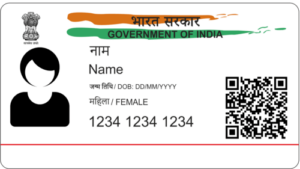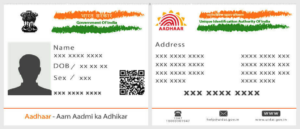Aadhaar Card: An Aadhaar card is a 12-digit identification number issued by the government of India to every resident of India. It serves as proof of identity and address and is considered one of India’s most important documents. The Aadhaar card was launched in 2009 to provide a unique identity to every citizen and reduce instances of identity fraud. In this article, we will discuss the Aadhaar card in detail, its history, benefits, and concerns related to privacy and security.

History of Aadhaar Card
The idea of a unique identification number for Indian citizens was first proposed in 2006 by the Planning Commission. The commission aimed to provide a unique identity to every Indian citizen, especially those marginalized and lacking proper identification documents. The UIDAI (Unique Identification Authority of India) was established in January 2009 to implement the Aadhaar project.
The Aadhaar card was launched on 29th September 2010 and since then, the government has been working to enroll every resident of India into the Aadhaar system. The enrolment process involves collecting biometric and demographic information of an individual, including fingerprints and iris scans, along with other personal details such as name, address, date of birth, and gender.
Benefits of an Aadhaar Card
The Aadhaar card has brought many benefits to the citizens of India. A few of the benefits are:
- Easy Access to Government Services: The Aadhaar card has made it easier for citizens to access government services such as subsidies, pension schemes, and scholarships. The government has made it mandatory for citizens to link their Aadhaar card to various services such as PAN, LPG connections, bank accounts, and mobile phone connections. This has made availing of these services much more accessible and hassle-free.
- Reduction of Duplicate Entries: The Aadhaar card has reduced the instances of duplicate entries in government databases. With the help of the Aadhaar card, the government can now identify individuals with multiple identities and prevent them from availing of numerous benefits from the government.
- Increased Financial Inclusion: The Aadhaar card has helped increase financial inclusion in India. With the help of the Aadhaar card, individuals who did not have access to formal banking services can now open bank accounts and avail of various financial services.
- Improved Delivery of Services: The Aadhaar card has improved the delivery of services in India. With the help of the Aadhaar card, the government can now directly transfer subsidies and other benefits to citizens’ bank accounts, reducing corruption and leakages in the system.
Concerns Related to Privacy and Security
The Aadhaar card has raised concerns related to privacy and security. The sensitive personal information collected during the enrolment process is stored in a central database and is accessible to various government agencies. This has raised concerns about citizens’ privacy and their personal information security.
Additionally, there have been data breaches and unauthorized access to the Aadhaar database, which have raised concerns about the security of personal information. There have also been reports of individuals being denied access to various services due to errors in their Aadhaar card information, which has raised questions about the reliability of the Aadhaar system.
Eligibility Criteria for Aadhaar Card
The Aadhaar card is available to all residents of India, regardless of age, gender, religion, or income. However, certain eligibility criteria must be met to apply for an Aadhaar card:
- Residency: The individual must have lived in India for at least 182 days in the past 12 months to be eligible for an Aadhaar card. This requirement ensures that the Aadhaar card is only issued to individuals who are residents of India.
- Age: Individuals above the age of 5 years are eligible to apply for an Aadhaar card. For children between the ages of 5 to 15 years, a parent or guardian must accompany them to the enrolment center. Children below the age of 5 years are not required to enroll for Aadhaar but can do so if their parents or guardians wish.
- Document Requirements: The individual must provide proof of identity, address, and date of birth to apply for an Aadhaar card. These documents are used to verify the individual’s identity, address, and date of birth and ensure that the Aadhaar card is issued to the correct person.
Applying for Aadhaar Card
The process of applying for an Aadhaar card is simple. An individual can visit an Aadhaar enrolment center, fill in the enrolment form, and provide their biometric and demographic information. The following documents are required to apply for an Aadhaar card:
- Proof of Identity: This could be a passport, PAN card, driving license, voter ID card, or government-issued ID. The proof of identity is used to verify the individual’s identity and ensure that the Aadhaar card is issued to the correct person.
- Proof of Address: This could be a utility bill, bank statement, ration card, or any other government-issued document that contains the individual’s address. The proof of address is used to verify the individual’s address and ensure that the Aadhaar card is sent to the correct address.
- Proof of Date of Birth: This could be a birth certificate, 10th class certificate, passport, or any other government-issued document that contains the individual’s date of birth. The proof of birth is used to verify the individual’s date of birth and ensure that the Aadhaar card reflects the correct age of the individual.
- Once the enrolment form is submitted and the required documents are completed, the individual’s biometric and demographic information will be recorded. This includes the individual’s fingerprints, iris scans, and photographs. The biometric information is used to verify the individual’s identity and ensure that the Aadhaar card is unique and cannot be duplicated.
- After the biometric and demographic information is recorded, a 12-digit Aadhaar number will be generated. The Aadhaar card will be dispatched to the individual’s address within 60 to 90 days. The individual can track the status of their Aadhaar card online and receive regular updates on the status of their Aadhaar card through email or SMS.
The information contained in an Aadhaar card:

Demographic Information: The first component of an Aadhaar card is demographic information, which includes the cardholder’s name, date of birth, gender, address, and other personal details. This information is used for identity verification and is updated periodically to ensure accuracy.
- Biometric Information: The second component of an Aadhaar card is biometric information, which includes the cardholder’s photograph, fingerprints, and iris scan. This information is used for authentication purposes and is captured during the enrollment process. The biometric information is stored securely in the UIDAI (Unique Identification Authority of India) database. It is used for identity verification whenever the Aadhaar card is used for government services or subsidies.
- Unique Identification Number: The third and most important component of an Aadhaar card is the unique 12-digit identification number. This number serves as a unique identifier for the cardholder and is used for identity verification and tracking purposes. The Aadhaar number is linked to the cardholder’s demographic and biometric information and is used for authentication whenever the Aadhaar card is used.
- QR Code: An Aadhaar card also contains a Quick Response (QR) code, a two-dimensional barcode that can be scanned using a smartphone or QR code scanner. The QR code contains the cardholder’s demographic information, including their name, address, and photograph. This allows quick and easy verification of the cardholder’s identity without requiring manual checking.
Bal Aadhaar for Minors: What You Need to Know
Bal Aadhaar is the equivalent of Aadhaar for minors, children below the age of 5 in India. It’s a unique 12-digit identification number assigned by the Indian government and serves as proof of identity and address for the child. In this article, we’ll cover the eligibility criteria, required documents, and steps in obtaining Bal Aadhaar for a minor.
- Eligibility: To be eligible for Bal Aadhaar, a child must be below 5 years of age and accompanied by one of the parents with a valid Aadhaar card.
- Required Documents: The following documents are necessary when applying for Bal Aadhaar: the child’s birth certificate, the parent’s Aadhaar card, and proof of the parent’s address.
- Application Process: To apply for Bal Aadhaar, visit an Aadhaar enrollment center, fill out the enrollment form, and submit the required documents. The child’s biometric information will be captured, including fingerprints and a photograph. The parent’s Aadhaar card will then be linked to the child’s Bal Aadhaar card, which will be issued within 90 days of the enrollment.
Benefits of Bal Aadhaar: Bal Aadhaar offers numerous benefits for minors, including serving as proof of identity, linking to various services such as bank accounts, mobile numbers, and voter IDs, and providing access to government services and subsidies. It’s also convenient as it eliminates the need for multiple identity and address verification documents.
Uses of Aadhaar Card
The Aadhaar card has become an important document in India and is required for various government services and subsidies. Some of the most common uses of the Aadhaar card are:
- Banking: The Aadhaar card is linked to the individual’s bank account and is used for various banking transactions, including opening a new bank account, applying for a loan, or making a deposit or withdrawal.
- Taxation: The Aadhaar card is used for filing income tax returns and is also required for availing of various tax benefits and subsidies.
- Government Services: The Aadhaar card is required for availing of various government services, such as LPG subsidies, pension schemes, and social welfare programs.
- Mobile Connections: The Aadhaar card is linked to the individual’s mobile number and is used to verify the mobile subscriber’s identity.
- Voter ID: The Aadhaar card can be linked to the individual’s voter ID card and is used for voter verification.
- Passport: The Aadhaar card is used for fast-tracking the passport application process and is required for expedited passport issuance.
In conclusion, Aadhaar is a unique identification system that serves as proof of identity and address for residents of India. It contains demographic information, biometric information, a unique identification number, and a QR code. The Aadhaar card has numerous benefits, including serving as a single document for identity and address verification, linking to various services, and providing access to government services and subsidies. With the Aadhaar card, the government of India aims to provide a secure and convenient identification system for all residents of the country.
Leave a Reply